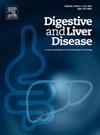Transjugular Intrahepatic Portosystemic Shunt (TIPS) as possible therapeutic strategy for refractory ascites with early-onset after liver transplantation
IF 3.8
3区 医学
Q1 GASTROENTEROLOGY & HEPATOLOGY
引用次数: 0
Abstract
Background
Early-onset ascites after liver transplantation (LT) is an uncommon complication, affecting approximately 6% of LT recipients. It is primarily associated with vascular complications, acute cellular rejection, and, historically, with early hepatitis C recurrence. The incidence and natural history of post-LT ascites in the modern era remain poorly characterized, and current diagnostic and therapeutic approaches are not well defined. While transjugular intrahepatic portosystemic shunt (TIPS) is a standard therapy for refractory ascites in cirrhosis, its role in the post-LT setting is less well established.
Aim
To evaluate the clinical characteristics and outcomes of LT recipients treated with TIPS for early post-LT ascites.
Methods
We conducted a retrospective, descriptive study of adult LT recipients who developed early-onset ascites, defined as ascites requiring paracentesis and persisting beyond 6 months, and subsequently underwent TIPS placement at our center between January 2016 and May 2025. Data collected included pre-LT characteristics, surgical details, etiology of ascites based on histological and hemodynamic findings, and TIPS procedural information. Clinical outcomes included periprocedural complication, ascites resolution within 3 months post-TIPS placement and graft and patient survival.
Results
During the study period 1080 patients received LT and a total of 10 (0,9%) patients underwent TIPS placement for early-onset ascites post-LT (6, [60%] male with median age 60 [IQR 50-62]). Main indication to LT was hepatocellular carcinoma (6, 60%) with a median Model of End Stage Liver Disease (MELD)-Na of 10 (IQR 8-22). Only two (20%) patients had ascites pre-LT. They mostly received donation after brain death donors (6, 60%) and all underwent caval anastomosis through piggy-back technique. Hemodynamic study and transjugular liver biopsy were performed in all the patients. Mean hepatic venous pressure gradient was 11 (IQR 6-16) mmHg, whereas a pathological gradient between hepatic vein and right atrium was found in 8 (80%) cases. Consistently, liver biopsy revealed features of hepatic venous outflow obstruction in 6 patients (60%), and signs of acute rejection in 6 (60%) as well, with overlapping findings in some cases. Mean interval time between LT and TIPS was 72 (IQR 47-88) days with mean portal pressure gradient of 7 (IQR 5-8) mmHg. All the procedure were technically feasible. Three patients (30%) showed a transient elevation in bilirubin and transaminases, of whom only one patient showed radiological feature of ischemic hepatitis. Other minor complications included a case of acute kidney injury and indirect hyperbilirubinemia due to intra-shunt hemolysis. All the condition were self-limiting. Early clinical success in resolving ascites was achieved in 8 out of 10 patients (80%). After a median follow-up of 25 (IQR 5-53) months one patients died for extrahepatic cancer. All the patients resolved ascites; however, 4 (40%) patients experienced at least one episode of hepatic encephalopathy post TIPS.
Conclusions
TIPS appears feasible and potentially effective for managing early-onset ascites post-LT with early clinical success and with manageable complications. Long term outcomes can potentially be affected by the occurrence of hepatic encephalopathy. Further studies are needed to confirm these findings, refine selection criteria and optimize preventive strategy in long term follow-up, but the favorable outcomes observed in our cohort highlight its potential clinical benefit.
经颈静脉肝内门静脉系统分流术(TIPS)作为早期肝移植术后难治性腹水的可能治疗策略
肝移植术后早发性腹水是一种罕见的并发症,约6%的肝移植受者受到影响。它主要与血管并发症、急性细胞排斥反应以及早期丙型肝炎复发有关。lt后腹水的发生率和自然历史在现代仍然缺乏特征,目前的诊断和治疗方法没有很好的定义。虽然经颈静脉肝内门体分流术(TIPS)是肝硬化难治性腹水的标准治疗方法,但其在肝移植后的作用尚不明确。目的探讨TIPS治疗早期肝移植后腹水的临床特点及预后。方法:我们对发生早发性腹水(定义为需要穿刺并持续超过6个月的腹水)的成人LT受体进行了回顾性描述性研究,随后于2016年1月至2025年5月在我们的中心接受了TIPS放置。收集的数据包括肝移植前的特征、手术细节、基于组织学和血流动力学发现的腹水病因,以及TIPS手术信息。临床结果包括围手术期并发症、tips放置和移植后3个月内腹水消退和患者生存。结果在研究期间,1080例患者接受了肝移植,共有10例(0.9%)患者接受了肝移植后早发性腹水的TIPS放置(6例,[60%]男性,中位年龄60岁[IQR 50-62])。肝移植的主要适应症为肝细胞癌(6.60%),终末期肝病模型(MELD)的中位na为10 (IQR 8-22)。只有2例(20%)患者在肝移植前有腹水。脑死亡供者多为脑死亡供者(6.60%),均采用背囊吻合。所有患者均行血流动力学检查和经颈静脉肝活检。平均肝静脉压梯度为11 (IQR 6-16) mmHg, 8例(80%)肝静脉与右心房之间存在病理性梯度。与此一致的是,肝活检显示6例(60%)患者有肝静脉流出梗阻的特征,6例(60%)患者也有急性排斥反应的迹象,在一些病例中有重叠的发现。LT和TIPS的平均间隔时间为72 (IQR 47-88)天,平均门静脉压力梯度为7 (IQR 5-8) mmHg。所有的程序在技术上都是可行的。3例患者(30%)表现为胆红素和转氨酶的短暂升高,其中只有1例患者表现为缺血性肝炎的影像学特征。其他轻微并发症包括一例急性肾损伤和分流内溶血引起的间接高胆红素血症。所有的条件都是自我限制的。10例患者中有8例(80%)在解决腹水方面取得早期临床成功。中位随访25 (IQR 5-53)个月后,1例患者死于肝外癌。所有患者腹水均消失;然而,4例(40%)患者在TIPS术后至少出现一次肝性脑病发作。结论stips治疗肝移植后早发性腹水是可行且有效的,临床早期成功且并发症可控。肝性脑病的发生可能影响长期预后。需要进一步的研究来证实这些发现,在长期随访中完善选择标准和优化预防策略,但在我们的队列中观察到的良好结果突出了其潜在的临床益处。
本文章由计算机程序翻译,如有差异,请以英文原文为准。
求助全文
约1分钟内获得全文
求助全文
来源期刊

Digestive and Liver Disease
医学-胃肠肝病学
CiteScore
6.10
自引率
2.20%
发文量
632
审稿时长
19 days
期刊介绍:
Digestive and Liver Disease is an international journal of Gastroenterology and Hepatology. It is the official journal of Italian Association for the Study of the Liver (AISF); Italian Association for the Study of the Pancreas (AISP); Italian Association for Digestive Endoscopy (SIED); Italian Association for Hospital Gastroenterologists and Digestive Endoscopists (AIGO); Italian Society of Gastroenterology (SIGE); Italian Society of Pediatric Gastroenterology and Hepatology (SIGENP) and Italian Group for the Study of Inflammatory Bowel Disease (IG-IBD).
Digestive and Liver Disease publishes papers on basic and clinical research in the field of gastroenterology and hepatology.
Contributions consist of:
Original Papers
Correspondence to the Editor
Editorials, Reviews and Special Articles
Progress Reports
Image of the Month
Congress Proceedings
Symposia and Mini-symposia.
 求助内容:
求助内容: 应助结果提醒方式:
应助结果提醒方式:


